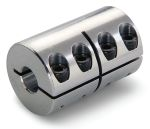 In need of a coupling for a high tech application? But which type should you go for – rigid, beam, bellows, disc, oldham, jaw? Ruland Manufacturing takes a look into each of these and guides us through their features
In need of a coupling for a high tech application? But which type should you go for – rigid, beam, bellows, disc, oldham, jaw? Ruland Manufacturing takes a look into each of these and guides us through their features
High tech applications in industries such as medical, semiconductor, solar, packaging and printing require precision components to maintain a high degree of accuracy and repeatability. The shaft coupling is an important component of such systems – used, for example, to connect servo motors to linear systems. For such applications, Ruland offers a variety of servo couplings including: rigid couplings, beam couplings, bellows couplings, disc couplings, oldham couplings and zero-backlash jaw couplings.
Rigid Couplings
In the past, design engineers would not consider using rigid couplings in high tech applications due to their large mass and common misconceptions about their performance. However, small bore rigid couplings, especially those made from low inertia aluminium, are increasingly used for their torsional stiffness, high torque capacity, and zero-backlash performance.
For additional performance benefits, the company hones straight bore rigid couplings for proper fit and alignment, which is important for applications that require strict control of tolerances. Precision honing assures precise roundness, straightness and collinearity of the bores and a larger percentage of shaft contact for greater torque transmission ability. Ruland also uses proprietary Nypatch anti-vibration hardware which prevents the screws from loosening during operation for increased coupling reliability.
 Beam Couplings
Beam Couplings
Designed with multiple sets of two or three spiral cuts, the four and six beam couplings are well suited to light duty applications. Manufactured from aluminium, the multiple cut design offers low inertia and accommodation of angular and parallel misalignment as well as axial motion. The single piece design with multiple cut patterns yield backlash-free operation and allow for a small amount of shock absorption. Stainless steel versions are also available for applications requiring higher torque transmission capabilities and corrosion resistance.
Six beam couplings have three sets of short spiral cuts to provide a high torque capacity and torsional stiffness. This is especially useful for demanding reversing servo motor applications where it is vital to maintain system reliability.
Four beam couplings are more compact with two sets of longer spiral cuts to offer extra flexibility with low bearing loads. A smaller size helps to reduce inertia, allowing the coupling to be highly responsive while retaining torsional stiffness. The four beam coupling is good for precision applications which use delicate components such as encoders and tachometers, where large amounts of windup could lead to inaccurate readings.
Bellows couplings
For superior performance in high tech applications, bellows couplings combine aluminium hubs with a stainless steel bellows. This lightweight design results in a torsionally stiff coupling which offers a high degree of accuracy and repeatability. The thin walls of the bellows allow the coupling to flex easily while remaining rigid under torsional loads. As a result, the bellows coupling is able to accommodate small amounts of parallel misalignment, angular misalignment and axial motion, while maintaining a low bearing load.
An important feature of this type of coupling is its balanced design, which reduces vibration in applications up to 10,000 RPM. These are also zero-backlash with no moving parts, assuring a long, maintenance-free life. Such characteristics mean these are well suited to high-end servo, stepper, encoder, and positioning applications.
Disc couplings
Disc couplings are comprised of two aluminium hubs and multiple flat stainless steel disc springs. With similar performance capabilities as the bellows, the thin disc springs allow for a greater misalignment capability with a small decrease in overall performance. Available in single and double disc styles, disc couplings are torsionally stiff and well suited for precise zero-backlash systems with speeds up to 10,000 rpm.
Although ideal for applications where a compact installation is required, single disc couplings can not accommodate parallel misalignment. To overcome this shortfall, double disc couplings have a centre spacer separating two sets of disc springs which can bend independently from each other. This design increases misalignment capabilities and allows for parallel misalignment. The centre spacer is available from Ruland in a choice of anodised aluminium for better performance or insulating acetal for electrical isolation.
 Oldham couplings
Oldham couplings
Oldham couplings are an assembly of two aluminium hubs with drive tenons that slide on a floating centre disk to transmit torque with zero-backlash. This design is particularly well suited to applications which require a large amount of parallel misalignment with a low bearing load. The three piece design results in a highly customisable shaft coupling which can easily combine inch to metric, different bore dimensions, and keyed shafts. Ruland offers the centre disk in acetal plastic for high torsional stiffness and zero-backlash, or nylon for shock absorption and noise reduction.
Ideal for many light duty industrial and high tech applications, oldham couplings are electrically isolating due to the non-conductive material of the centre disk. This prevents electrical current from being passed to delicate instruments which can cause inaccurate data readings or damage. The centre disk will also act as a torque limiter during overload to protect more expensive machinery components. When the disk fails, it breaks cleanly and does not allow any transmission of power.
Zero-backlash jaw couplings
The jaw coupling is also a three piece design comprised of two aluminium hubs and an elastic element called the ‘spider’. Made of an advanced polyurethane material, the spider provides dampening of impulse loads, minimising shock to the servo motor and other sensitive equipment.
Available from Ruland in three durometers, the spider allows the user to tailor the performance of the jaw coupling, such as torsional stiffness, misalignment, and dampening requirements, to their application. For added customisation, metric and inch hubs (set screw, clamp style, keyed, or keyless) are interchangeable and can be combined into a single coupling.
The jaw couplings feature a curved profile hub which press fits onto the spider assuring zero-backlash operation for high tech applications. The curved jaw profile concentrates the forces to the centre of the spider’s limbs, improving the effectiveness of the elastomer material. Raised contact points on the spider limbs help maintain proper spacing between the two hubs, assuring electrical isolation and full angular misalignment capabilities. Jaw couplings are considered fail safe because the jaws of the two hubs interlock for direct power transmission if the spider was to fail, allowing the application to be safely shut down for maintenance.
Ruland couplings are available in the UK from Techdrives.
Ruland
Techdrives
T: 01234 321320

